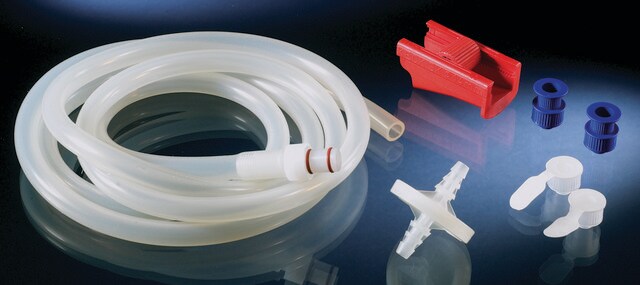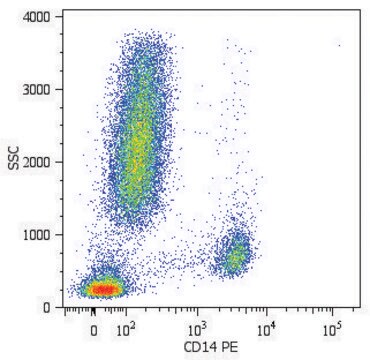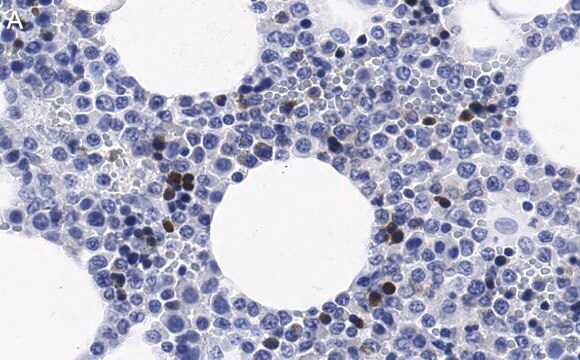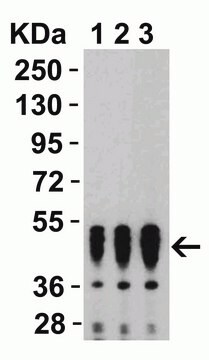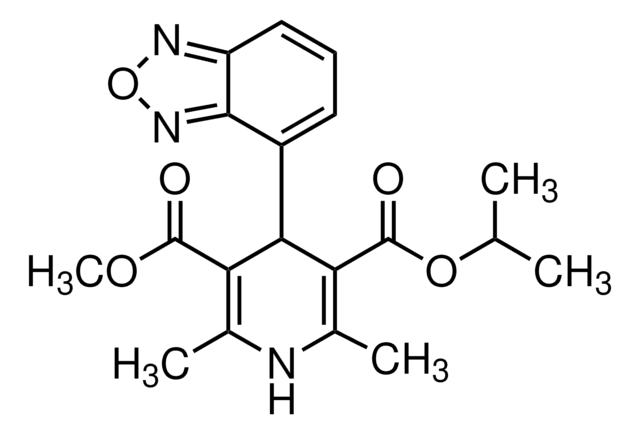추천 제품
생물학적 소스
mouse
Quality Level
결합
FITC conjugate
항체 형태
purified immunoglobulin
항체 생산 유형
primary antibodies
클론
ICRF44, monoclonal
양식
buffered aqueous solution
분자량
antigen 165-170 kDa
종 반응성
human
저장 조건
protect from light
기술
flow cytometry: 10 μL using 1 × 106 cells
동형
IgG1
UniProt 수납 번호
배송 상태
wet ice
저장 온도
2-8°C
타겟 번역 후 변형
unmodified
유전자 정보
human ... ITGAM(3684)
유사한 제품을 찾으십니까? 방문 제품 비교 안내
관련 카테고리
일반 설명
CD11b is an α/β heterodimeric glycoprotein. It belongs to the β2 integrin family and also referred as Mac-1, CR3, MO-1, and C3bi receptor.
Monoclonal Anti-Human CD11b antibody (mouse IgG1 isotype) is derived from the hybridoma produced by the fusion of mouse myeloma cells and splenocytes from BALB/c mice immunized with the human monocytes. CD11b is expressed on the surface of circulating monocytes, granulocytes, and certain natural killer (NK) cells. It is also present on subsets of macrophages. CD11b is present in subcellular granules and is translocated to the surface after activation.
특이성
Recognizes the CD11b α-chain of the human CD11b/CD18 complex. The antibody is useful for studies on cell adhesion and migration and for the detection of leukocyte adhesion deficiencies. It may be used to stain acetone-fixed cryostat sections or cell preparations. The epitope recognized by the antibody is formalin sensitive.
2nd Workshop: code no. M104
3rd Workshop: code no. 202 and 238
4th Workshop: code no. M47
2nd Workshop: code no. M104
3rd Workshop: code no. 202 and 238
4th Workshop: code no. M47
면역원
human monocytes.
애플리케이션
Anti-CD11b-FITC antibody is suitable for flow cytometric analysis of CD11b expression in RA-induced differentiation of human promyelocytic leukemia cells. It is also suitable for flow cytometric analysis of spleen cells to study the beneficial effects of dietary consumption of n-3 polyunsaturated fatty acids (PUFA) and two selective estrogen receptor modulator (SERM) derivatives.
생화학적/생리학적 작용
Anti-CD11b-FITC antibody is expressed on the surface of circulating monocytes, granulocytes, and certain NK cells. It is also present on subsets of macrophages and in subcellular granules of granulocytes. Upon activation, it translocates to the surface. It forms a CD11b/CD18 complex to participate in a variety of cell-cell and cell-substrate interactions such as attachment and phagocytosis of particles coated with C3bi by granulocytes and macrophages and phagocytosis of opsonized pathogens. It also plays a role in the initiation of a coagulation protease cascade and in cell migration mechanisms.
Surface expression of cluster of differentiation molecule CD11b/CD18 is capable of both functional and quantitative upregulation. CD11b/CD18 functions as a receptor for C3bi, clotting factor X, fibrinogen, and intercellular adhesion molecule 1 (ICAM-1). CD11b/CD18 is involved in a variety of cell-cell and cell-substrate interactions such as attachment and phagocytosis of particles coated with complement receptor type 3 (C3bi) by granulocytes and macrophages and phagocytosis of opsonized pathogens. It also plays a role in the initiation of a coagulation protease cascade and in cell migration mechanisms. The endothelial cell counter-receptor for CD11b/CD18 is ICAM-1. Monoclonal Anti-Human CD11b can be used to stain acetone-fixed cryostat sections or cell preparations. The epitope recognized by the antibody is formalin sensitive.
표적 설명
CD11b α-chain of the human CD11b/CD18 complex is an α/β heterodimeric glycoprotein which belongs to the β2 integrin family. It is also known as Mac-1, CR3, MO-1 and C3bi receptor. CD11b is expressed on the surface of circulating monocytes, granulocytes and certain NK cells and is also present in subsets of macrophages. It functions as a receptor for iC3b, clotting factor X, fibrinogen and ICAM-1.
물리적 형태
Solution in 0.01 M phosphate buffered saline, pH 7.4, containing 1% bovine serum albumin and 15 mM sodium azide.
제조 메모
Prepared by conjugation to fluorescein isothiocyanate isomer I (FITC). This green dye is efficiently excited at 495 nm and emits at 525 nm.
면책조항
Unless otherwise stated in our catalog or other company documentation accompanying the product(s), our products are intended for research use only and are not to be used for any other purpose, which includes but is not limited to, unauthorized commercial uses, in vitro diagnostic uses, ex vivo or in vivo therapeutic uses or any type of consumption or application to humans or animals.
적합한 제품을 찾을 수 없으신가요?
당사의 제품 선택기 도구.을(를) 시도해 보세요.
Storage Class Code
10 - Combustible liquids
WGK
nwg
Flash Point (°F)
Not applicable
Flash Point (°C)
Not applicable
Fibrinogen stimulates macrophage chemokine secretion through toll-like receptor 4
Smiley ST, et al.
Journal of immunology (Baltimore, Md. : 1950), 167(5), 2887-2894 (2001)
L Zeitlin et al.
Journal of cellular biochemistry, 90(2), 347-360 (2003-09-25)
We studied the beneficial effects of dietary consumption of n-3 polyunsaturated fatty acids (PUFA) and two selective estrogen receptor modulator (SERM) derivatives (SERM-I and SERM-II) and their combined effect on serum lipids, skin dermis and adipose layers, bone marrow adipogenesis
D I Beller et al.
The Journal of experimental medicine, 156(4), 1000-1009 (1982-10-01)
Anti-Mac-1 (M1/70), a rat monoclonal antibody that reacts with mouse and human macrophages, polymorphonuclear leukocytes (PMNL), and natural killer cells, selectively inhibited complement receptor-mediated rosetting by murine macrophages and human PMNL. Preincubation of macrophages with anti-Mac-1 inhibited formation of rosettes
CD11b-mediated migratory property of peripheral blood B cells
Kawai K, et al.
The Journal of Allergy and Clinical Immunology, 116(1), 192-197 (2005)
Membrane proteins involved in phagocyte adherence to endothelium.
T M Carlos et al.
Immunological reviews, 114, 5-28 (1990-04-01)
자사의 과학자팀은 생명 과학, 재료 과학, 화학 합성, 크로마토그래피, 분석 및 기타 많은 영역을 포함한 모든 과학 분야에 경험이 있습니다..
고객지원팀으로 연락바랍니다.


